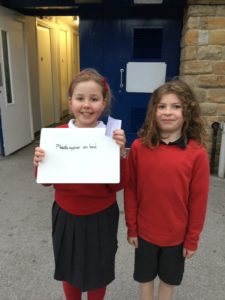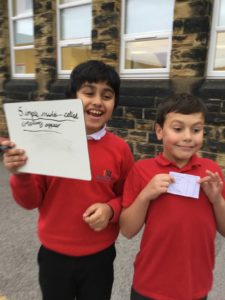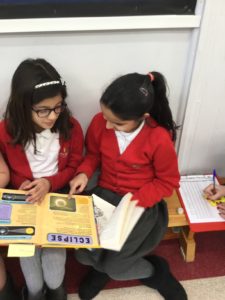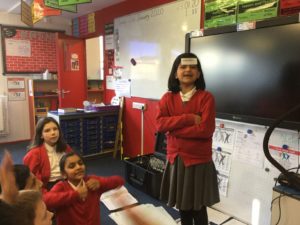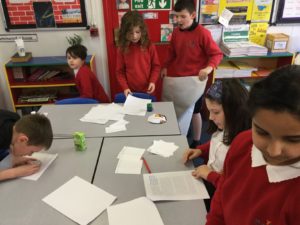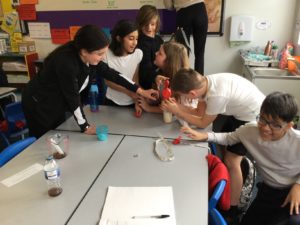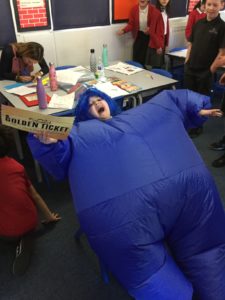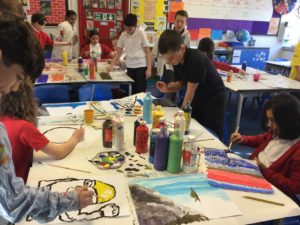Reading: inference skills through drama
In our reading lesson this morning, we’ve been using drama to show our understanding of a character’s feelings at different points in a story.

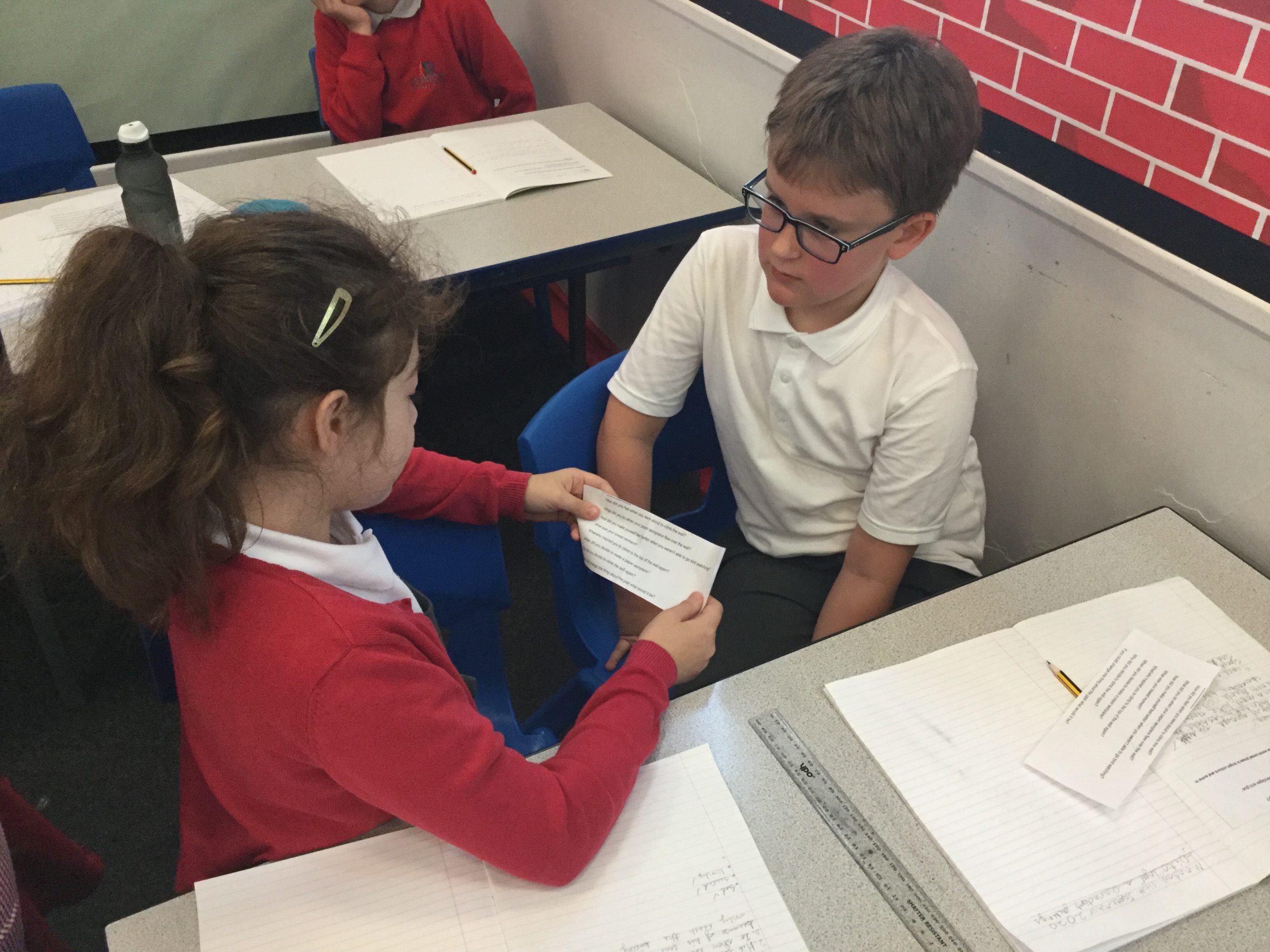

Welcome back Y3!
I’ve been extremely impressed at how well Year 3 have adapted to life back in school! They’ve got on with everything so far with no trouble at all – it’s like they’ve had no time away!
This week, we have enjoyed lots of different learning.
In maths, we recapped our tens and ones and have moved onto learning about hundreds, too! We’ve been making silly stories involving aliens and sweets to help us with our maths learning!
In reading, we made predictions and inferences with our new class novel: After the Fall. Nobody was able to predict the plot twist at the end though!
In writing, we were remembering what makes a sentence and then starting sentences using different words, such as:
Humpty nervously climbed the ladder.
became
Nervously, Humpty climbed the ladder.
See if your child can remember the things that make a sentence! Tip: one of them is a capital letter to start the sentence.
We have enjoyed learning about different classes of animals in science, too.
Edith correctly remembered that reptiles can normally be distinguished by the fact that they lay eggs on land; have dry, scaly skin; and are cold-blooded!
To help at home, practise reading with your child everyday. This can be anything from reading instructions on how to make a cake, talking about what they’ve read at school, going on Lexia (logins to be sent home tomorrow) to reading this post together!
Make sure your child practises their times tables everyday, too. The logins for Times Table Rock Stars are to be sent home tomorrow as well.
Here’s to another successful week!
Mr Wain
Our first week
The first group of children have started school and been amazing!
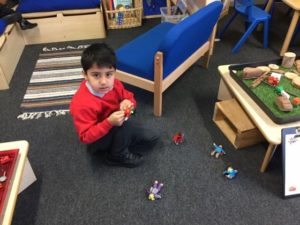
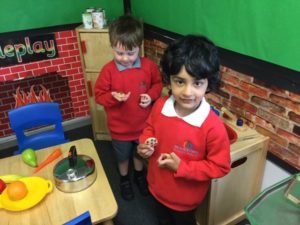
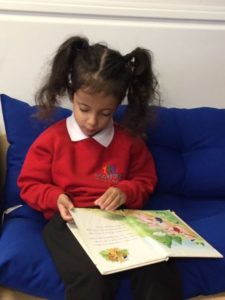
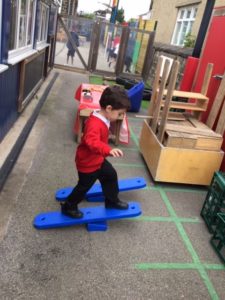

We look forward to meeting more of you next week.
If you have any questions or concerns please contact us via our Reception Class email.
We value the knowledge and understanding you have of your child so we’d like you to be involved. It would be really helpful if you let us know what they enjoy out of school and if possible take some photos.
This information will help us plan activities to meet your child’s needs and motivate their learning.
Let us know of any ‘wow’ moments that happen at home by sending photos of your child’s achievements.
moortowneyfs@spherefederation.org
The Reception Team
Teacher – Mrs Burke
Teaching Assistants-
Mrs Burgess
Miss Billard
Mrs Stewart
Science: learning about animals
In today’s science lesson we’ve been using secondary research to find out about different animal classes.
We then used iPads to create a presentation about a particular class of animal.



Enjoying our shared area
We have been so impressed with all the children this week. On Monday, the class entered school with huge smiles on their faces and this has continued throughout the week. Coping with new routines can be difficult for us all. However, the children have modelled how to do this well and without fuss.
As well as the classroom, Year One also have a shared area that is used as a learning space. This allows us to present the children with further learning opportunities and we will be using this area as an extension to our classroom.
The children have been taught how to use the area correctly and the importance of keeping it tidy. Below, are a few snap shots of how we learn in our shared areas.



Welcome back!
Welcome back!
We’ve already started to settle into our new normal – I’ve been really impressed with how adaptable everyone has been.
It’s going to be a great year!
“I think the year ahead is going to be really exciting!” exclaimed Noah.
“I’m really looking forward to everything. It’s going to be hard but fun as well. I’m looking forward to learning new things,” said Rayn.
“It’ll be fun to make new friends!” Alishbah stated.
Daisy smiled, “This year is going to be odd but fun.”
I think you’ve hit the nail on the head there, Daisy.
In maths, we’re gradually building up to year six content by first recapping learning from year five to make sure everyone feels confident. We’re starting with place value (eg In 56,934 what does the 9 represent? It has nine hundreds.) before moving on to addition and subtraction.
Help at home by practising some simple addition and subtraction calculations such as 2,899 + 492 or 5,693 – 411.
In writing, we’re looking at instructions. We’ve already followed some to make some origami! Soon, we will be writing our own about caring for a mysterious creature.
Help at home by practising sentences that start in different ways. You could start with:
- an adjective eg ‘Textured or metallic paper can also be used for origami.’
- an adberb eg ‘Carefully, cut along the dotted line.’ Or: ‘Once you’ve folded the paper, flip it over.’
- a conjunction eg ‘Because this fold is fiddly, use a paper clip to flatten it.’
In reading, we’re using our whole school novel After the Fall. You should check it out – it’s a cracking read!
Help at home by reading every day! I can’t stress this enough. It doesn’t matter what it is, where it takes place or who is reading to who. Better readers make better learners. 🙂
In topic, we’ll be inspired by After the Fall. Watch out for paper aeroplanes, collages and even parachutes…
Own It app
Has you child got a mobile phone? If they have, do the have the Own It app from the BBC?
The Own It app helps children and young people take control of your online life. It gives them advice when they need it, in real-time as they type. It’s designed to help them make smart choices, feel more confident, and live their best life online.
The Own It app comes with a special keyboard. This can be used like any other keyboard, but it also gives users helpful tips and friendly advice as they write.
There’s also the ability to track how they feel and improve their wellbeing. There are plenty of gifs and emojis so users can express themselves.
The Own It keyboard and app is personal to the user. Everything your child types is kept completely private, and never leaves the Own It app on their phone.
Welcome Reception Class 2020
We are really excited to begin welcoming the new Reception children to school this week.
Please bring your children on the dates and times you have been given to ensure an easy and relaxing transition.
Things to bring:
Water bottle-please fill with water at home
Coat
Bookbag
Packed lunch if needed
A set of spare clothes-underwear/trousers/skirt
Please clearly label anything your child brings or wears into school with their name.
To avoid any disappointment or upset please leave all toys at home.This is especially important this year.
We are really looking forward to getting to know you all.
We’re ready…
Welcome back to school everyone! 
As we welcome the children into Year 1, we would like to reassure you that the classroom and shared areas are fully prepared, and meet current guidelines to ensure a happy and healthy return to school.
We’re looking forward to seeing the children and getting back into a routine.
Below is a list of key points to remember:
- Mrs Freeman will be teaching every Monday, Tuesday and Wednesday. Mrs Taylor will teach each Thursday and Friday.
- Mrs Bharath and Mrs Roth will also be working in Year 1.
- Parents are not to enter the cloakroom or classroom. If you need to speak with us, then please make an appointment at the office.
- Children DO NOT need to bring bookbags to school.
- Please ensure your child has a coat every day.
- Water bottles can be brought into school and can be refilled throughout the dy.
- Homework books will be brought home on Friday (11th) and will remain at home.
- Please email your child’s homework each week (by Thursday) and this will be shared in class. The children will be given a sheet of homework and new spellings every Friday. They will be tested on their spellings the following Friday. Please email jackiefreeman@spherefederation.org and carolinetaylor@spherefederation.org.
- PE is on a Tuesday and a Thursday. The children are being asked to come to school in their PE kits on those days. They will remain in their kit for the whole day.
- The school uniform policy is on our website. Please check if you are unsure about any items of clothing or footwear. https://www.moortown.leeds.sch.uk/find-out/policies/
- The staff and children will remain in their own ‘bubble’ throughout the day and regular hand sanitising will be carried out.
- We aim to let you know about reading books this week.
Thank you for your cooperation.
Mrs Freeman/Mrs Taylor
Goodbye Y5!
Dear Year 5,
What an absolute pleasure it has been to have you as my class this year. I couldn’t have asked for a more hardworking, fun, kind and generally awesome group of people to share my first year of teaching with.
I know that the end of the year hasn’t been what we expected it to be, but take nothing away from the commitment and effort you have demonstrated through this time and through the whole year – you guys should be extremely proud of yourselves.
I have no doubt that you will be amazing in Year 6 and I will always be around for a chat – I’m looking forward to seeing your faces again in September.
Have a wonderful and well deserved rest this summer!
Mr Wain

